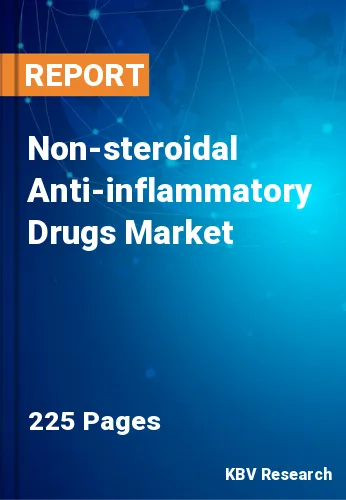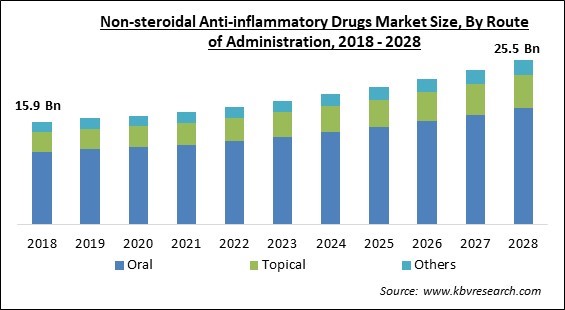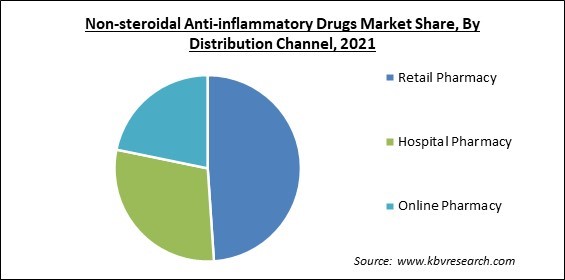
The Global Non-Steroidal Anti-inflammatory Drugs Market size is expected to reach $25.5 billion by 2028, rising at a market growth of 5.7% CAGR during the forecast period.
Non-steroidal anti-inflammatory medications (NSAIDs) are used to alleviate pain, lower fevers, and improve blood circulation. Furthermore, the inflammation is decreased when high dosages of non-steroidal anti-inflammatory medicines (NSAIDs) are given. Non-steroidal medications have sedative and anti-inflammatory effects. Inflammation is caused by the COX-1 and COX-2 enzymes that are inhibited by non-steroidal anti-inflammatory medications (NSAIDs). Aspirin, naproxen, ibuprofen, and paracetamol are examples of typical non-steroidal anti-inflammatory medications.

The market for non-steroidal anti-inflammatory medications (NSAIDs) is expanding as a result of a number of causes, including the growing incidence of chronic pain worldwide and an ageing population. The expanding use of NSAIDs for headache, toothache, migraine, and menstrual pain, as well as growing preference for OTC NSAIDs, are also anticipated to contribute to the growth over the forecast period. Additionally, the accessibility of a wide range of NSAID products as well as an increase in product approvals and launches are projected to fuel growth over the forecast period.
During the projected period, the prevalence of chronic pain is anticipated to increase, driving NSAID market growth. For instance, the CDC estimates that in the United States, about 20,4% of adults experienced chronic pain in 2019. Age-related increases in the prevalence of chronic pain were most pronounced in persons 65 years of age and older. Compared to Hispanic, non-Hispanic Asian, and non-Hispanic black individuals, non-Hispanic whites had the highest prevalence of chronic pain. About 23.6 percent of non-Hispanic white adults suffer from chronic discomfort. Therefore, given that both COX-2 selective and non-selective NSAIDs are frequently employed in the management of chronic pain, the increasing prevalence of chronic pain is anticipated to promote growth.
The infectious disease COVID-19 first surfaced in late December in the Chinese city of Wuhan's Hubei province. SARS-CoV-2, the virus that causes the acute respiratory syndrome is extremely contagious and spreads from person to person. The virus has spread to 213 nations since its outbreak in December 2019, prompting the World Health Organization to classify it as a pandemic. Governments and pharmaceutical and biotech businesses from all around the world are collaborating to combat the COVID-19 outbreak, from managing the medical supply chain to assisting in the creation of vaccinations. As a result, the demand for the COVID-19 vaccination and its treatment medications is predicted to propel the pharmaceutical and biotechnology sectors forward.
Pain that persists for more than 12 weeks without medication or treatment is referred to as chronic or persistent pain. Several people recover from pain due to injuries or operation and return to normalcy. However, there are situations when the pain lasts longer or appears suddenly without any prior history of an accident or surgery. One of the key factors propelling the market expansion for non-steroidal anti-inflammatory medications is the rising prevalence of disorders that cause pain and inflammation. These medications are being used more frequently to treat both acute & chronic pain. Ibuprofen & diclofenac are two medications that are frequently recommended to treat pain.

The most often recommended medications for the management of mild to severe pain are NSAIDs and opioids. Opioid use, however, is linked to serious adverse outcomes. Since the dawn of civilization thousands of years ago, opioids have been used to relieve pain. Opioid analgesics are frequently used to treat dull, ill-localized pain, typically abdominal pain. Frequent doses may result in drug tolerance and dependency, and abruptly stopping an opioid painkiller may trigger a withdrawal crisis. Non-opioid, non-steroidal anti-inflammatory medicines (NSAIDs), which do not include opioids, are the most often prescribed analgesics for the management of pain. At larger doses, these medications also have antipyretic, analgesics, and anti-inflammatory properties.
The market growth is anticipated to be constrained by adverse reactions to NSAID use, including allergic reactions, stomach pain, stomach ulcers, and dizziness. These pharmaceuticals are one of the most often prescribed medicines due to their widespread accessibility and anti-inflammatory effects. However, NSAID-related gastrointestinal issues are on the rise significantly globally, which could put a strain on the healthcare system. The most frequent reason for the most of emergency hospital admissions is GI bleeding related to NSAIDs. Additionally, its side effect is the most typical drug side in the United States.
Based on disease indication, the Non-steroidal Anti-inflammatory Drugs Market is segmented into Arthritis, Migraine, Ophthalmic Diseases and Others. The arthritis segment acquired the highest revenue share in the Non-steroidal Anti-inflammatory Drugs Market in 2021. The overall incidence of arthritis & osteoarthritis, the growing senior population worldwide, the strong prescription rate for NSAIDs, and the rise in popularity of topical arthritis treatments are all contributing factors to the segment's growth
By Route of Administration, the Non-steroidal Anti-inflammatory Drugs Market is classified into Oral, Topical and Others. The oral segment garnered the maximum revenue share in the Non-steroidal Anti-inflammatory Drugs Market in 2021. It is due to the abundance of oral NSAIDs available for treating pain, headaches, fever, and migraines as well as the rise in OTC NSAID sales. To treat headaches and migraines, Johnson & Johnson Consumer Inc. provides their NSAID medication Motrin (ibuprofen), which is offered in dose forms such a tablet, liquid gel, capsule, and solution.
On the basis of distribution channel, the Non-steroidal Anti-inflammatory Drugs Market is divided into Hospital Pharmacy, Retail Pharmacy and Online Pharmacy. The hospital pharmacy segment acquired a significant revenue share in the Non-steroidal Anti-inflammatory Drugs Market in 2021. It is because non-steroidal anti-inflammatory medications are widely used to treat pain in hospitalized patients. Along with that, the rise in the number of hospitals across various nations of the world would escalate the growth of the segment over the forecast period.
| Report Attribute | Details |
|---|---|
| Market size value in 2021 | USD 17.5 Billion |
| Market size forecast in 2028 | USD 25.5 Billion |
| Base Year | 2021 |
| Historical Period | 2018 to 2020 |
| Forecast Period | 2022 to 2028 |
| Revenue Growth Rate | CAGR of 5.7% from 2022 to 2028 |
| Number of Pages | 225 |
| Number of Tables | 360 |
| Report coverage | Market Trends, Revenue Estimation and Forecast, Segmentation Analysis, Regional and Country Breakdown, Companies Strategic Developments, Company Profiling |
| Segments covered | Route of Administration, Disease Indication, Distribution Channel, Region |
| Country scope | US, Canada, Mexico, Germany, UK, France, Russia, Spain, Italy, China, Japan, India, South Korea, Singapore, Malaysia, Brazil, Argentina, UAE, Saudi Arabia, South Africa, Nigeria |
| Growth Drivers |
|
| Restraints |
|
Region-wise, the Non-steroidal Anti-inflammatory Drugs Market is analyzed across North America, Europe, Asia Pacific and LAMEA. North America emerged as the leading region in the Non-steroidal Anti-inflammatory Drugs Market with the maximum revenue share in 2021. Some of the key variables influencing the market's growth include the existence of a sizable number of manufacturers and the strategic actions made by industry participants. In addition, it is predicted that the prevalence of arthritis and chronic pain will rise during the forecast period, accelerating growth.
Free Valuable Insights: Global Non-steroidal Anti-inflammatory Drugs Market size to reach USD 25.5 Billion by 2028
The market research report covers the analysis of key stake holders of the market. Key companies profiled in the report include Dr. Reddy’s Laboratories Ltd., Pfizer, Inc., GlaxoSmithKline PLC, Bayer AG, Teva Pharmaceuticals Industries Ltd., Eli Lilly And Company, Sanofi S.A., AstraZeneca PLC, Viatris, Inc., and Merck & Co., Inc.
By Route of Administration
By Distribution Channel
By Disease Indication
By Geography
The global Non-steroidal Anti-inflammatory Drugs Market size is expected to reach $25.5 billion by 2028.
Growing Incidence Of Chronic Pain are driving the market in coming years, however, Adverse Effects Of Nsaids Would Restrict Its Consumption restraints the growth of the market.
Dr. Reddy’s Laboratories Ltd., Pfizer, Inc., GlaxoSmithKline PLC, Bayer AG, Teva Pharmaceuticals Industries Ltd., Eli Lilly And Company, Sanofi S.A., AstraZeneca PLC, Viatris, Inc., and Merck & Co., Inc.
The expected CAGR of the Non-steroidal Anti-inflammatory Drugs Market is 5.7% from 2022 to 2028.
The Retail Pharmacy segment acquired maximum revenue share in the Global Non-steroidal Anti-inflammatory Drugs Market by Distribution Channel in 2021 thereby, achieving a market value of $11.8 billion by 2028.
The North America market dominated the Global Non-steroidal Anti-inflammatory Drugs Market by Region in 2021, and would continue to be a dominant market till 2028; thereby, achieving a market value of $8.8 billion by 2028.
Our team of dedicated experts can provide you with attractive expansion opportunities for your business.
